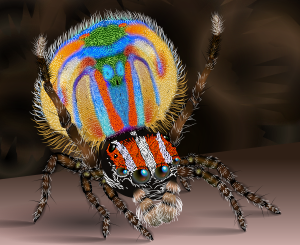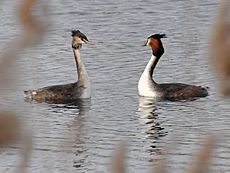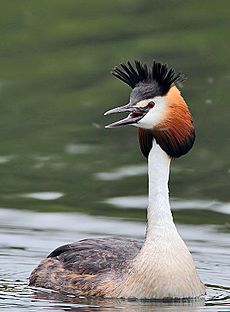Courtship in animals facts for kids
Courtship in animals is a set of display behaviors in which an animal, usually a male, attempts to attract a mate. These behaviors often include ritualized movement ("dances"), vocalizations, mechanical sound production, or displays of beauty, strength, or agonistic ability. Such display allows the male to present his traits or abilities to a female. Mate choice, in this context, is driven by females. Since the offspring of a female will inherit half of the genetic information from the male counterpart, those traits she saw as attractive will be passed on, producing fit offspring. In this case, males may compete during courtship by displaying desirable traits to pass on to offspring.
Many species are not limited to only one set of display behaviors. Some males create multi-modal signals.
Contents
Male display

In some species, males will perform ritualized movements to attract females. The male six-plumed bird-of-paradise (Parotia lawesii) exemplifies male courtship display with its ritualized "ballerina dance" and unique occipital and breast feathers that serve to stimulate the female visual system. In Drosophila subobscura, male courtship display is seen through the male's intricate wing scissoring patterns and rapid sidestepping.
In other species, males may exhibit courtship displays that serve as both visual and auditory stimulation. For example, the male Anna's hummingbird (Calypte anna) and calliope hummingbird (Stellula calliope) perform two types of courtship displays involving a combination of visual and vocal display—a stationary shuttle display and dive display. When engaging in the stationary shuttle display, the male displays a flared gorget and hovers in front of the female, moving from side to side while rotating his body and tail. The rhythmic movements of the male's wings produce a distinctive buzzing sound. When conducting a dive display, the male typically ascends approximately 20–35 m (66–115 ft) in the air then abruptly turns and descends in a dive-like fashion. As the male flies over the female, he rotates his body and spreads his tail feathers, which flutter and collide to produce a short, buzzing sound.
In Fiddler crabs (genus Uca), males have been sexually selected to have one enlarged claw, which can take up anywhere from a third to a half of their total body mass, and one regular claw. Although the enlarged claw is believed to have developed for use in combat for territorial defense, it is not uncommon for males to employ this claw in battle for a mate. Even though this claw developed as a weapon, it is also closely linked with the crabs' courtship display: it is waved in a certain pattern to attract females for mating.

In addition, some animals attempt to attract females through the construction and decoration of unique structures. This technique can be seen in the satin bowerbird (Ptilonorhynchus violaceus) of Australia, males of which build and decorate nest-like structures called "bowers". Bowers are decorated with bright and colourful objects (typically blue in colour) to attract and stimulate visiting females. Typically, males who acquire the largest number of decorations tend to have greater success in mating.
Female display
Female courtship display is less common in nature. Male choice in reproduction can arise if males are the sex in a species that are in short supply. This could arise in mating systems where reproducing comes at an energy cost to males. Such energy costs can include the effort associated in obtaining nuptial gifts for the female or performing long courtship behaviors. An added cost from these time and energy investments may come in the form of increased male mortality rates, putting further strain on males attempting to reproduce.
In pipefish (Syngnathus typhle), females use a temporary ornament, a striped pattern, to both attract males and intimidate rival females. In this case, the female of a species developed a sexually selected signal which serves a dual function of being both attractive to mates and deterring rivals.
Mutual display
Often, males and females will perform synchronized or responsive courtship displays in a mutual fashion. For example, male and female crested auklets, Aethia cristatella, will cackle at one another as a vocal form of mutual display that serves to strengthen a bond between the two. In some cases, males may pair up to perform mutual, cooperative displays in order to increase courtship success and attract females. This phenomenon can be seen with long-tailed manakins, Chiroxiphia linearis.
Wild turkeys (Meleagris gallopavo) also engage in co-operative displays in which small groups of males (typically brothers) work together to attract females and deter other competitive males. In many cases, only one male within the group will mate, typically the dominant male.
Sexual ornaments
Sexual ornaments can serve to increase attractiveness and indicate good genes and higher levels of fitness. When exposed to exaggerated male traits, some females may respond by increasing maternal investments. For example, female canaries have been shown to produce larger and denser eggs in response to male supranormal song production.
Extended courtship period
Mating is preceded by a courtship/pairing period in many animal mating systems. It is during this period that sexually mature animals select their partners for reproduction. This courtship period, which involves displays to attract a mate by a member of a species, is usually short, lasting anywhere from 15 minutes to a few days. However, certain animals may undergo an extended courtship period, lasting as long as two months.
One such exception is the emperor penguin (Aptenodytes forsteri). Emperor penguins engage in an extended courtship period that can last up to two months, the longest of any Arctic seabird. Their courtship period accounts for 16% of the total time they spend breeding, whereas in their closest relatives, the king penguin (Aptenodytes patagonicus), the courtship period takes up just three per cent of their breeding cycle.
Environmental factors
Various environmental factors, such as temperature, photoperiod, resource and light availability, have an effect on the timing and effectiveness of courtship displays in certain species of animals.
In guppies (Poecilia reticulata), variation in the light environment plays a huge role in their ability to attract mates. On average, male guppies seek out and spend more time in the environment in which their color pattern is the most visible.
In emperor penguins (Aptenodytes forsteri), resource availability determines when male emperor penguins will be able to return to their breeding grounds to initiate their courtship rituals. The greater the concentration of resources in their feeding ground, the quicker they will be able to restore their body reserves for winter, and the sooner they will be able to return to their breeding grounds. An early return to their breeding grounds comes with an increased likelihood of finding a mate.
The effectiveness of Hirtodrosophila mycetophaga mating displays is influenced by the color of the bracket fungus that it mates and courts upon; these flies choose brackets that are lighter, making their displays more visible to the opposite sex.
Related pages
Images for kids
-
God Speed by English artist Edmund Leighton, 1900: depicting an armored knight departing for war and leaving behind his wife/lover.
-
Courtship of green turtles
Courtship in animals







